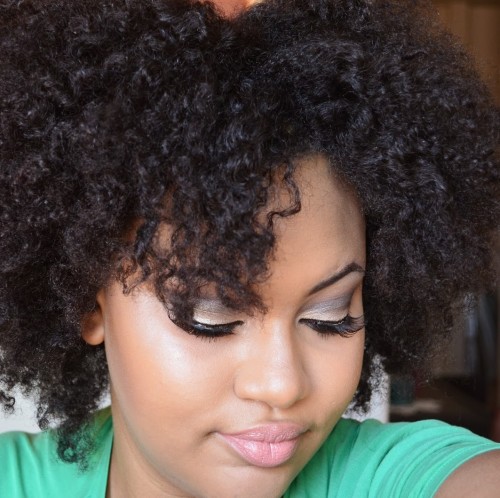Selected Politics Concerning Natural Hair

“Natural Afro American Hair” by AveryScott – Own work. Licensed under CC BY-SA 3.0 via Wikimedia Commons – https://commons.wikimedia.org/wiki/File:Natural_Afro_American_Hair.jpg#/media/File:Natural_Afro_American_Hair.jpg
The term “natural hair” is used in the African American community to differentiate between hair that has been left in its natural state and hair which has been permed (which is to permanently straighten the hair follicle with chemicals). African American hair in its natural state appears tightly coiled or kinky and is often socially stigmatized. Social stigmas are any idea that individuals associate with negative connotations. Many individuals would agree that hair is a prevailing symbol of one’s self and self-expression, contributing much stake towards one’s identity. As social norms change over time, so do the effects of symbols that an individual imposes on their social reality; as a consequence of being symbolic in society, hair speaks to a person’s status, power, beauty and beliefs (Bellinger 2007). Hair speaks to one’s character and is representative of their status in society. Hair is also a measure of beauty and how one styles their hair affects one’s level of beauty in society
Eurocentric Beauty Standards
Historically, a source of conflict has occurred in the realm of beauty and appearance with regards to African American women’s natural appearance and hegemonic beauty ideals. Hegemonic standards of beauty are those that would be considered conventionally attractive; these standards have been established by the majority ruling class and considered the norm of acceptable standards of appearance. Hair that deviated from the Eurocentric standard of anything less than straight, wavy, or a loosely curled hair pattern was considered unfeminine, and unattractive (Patton 2006). Thus historically, Black women with natural hair have been stigmatized as their natural hair did not meet the criterion for the hegemonic standard of beauty. These negative connotations associated with natural hair go beyond hegemonic beauty standards and are based on a systemic oppression and suppression of Black ideals and features that stem from racist ideals dating back to slavery. This oppression is vital when considering that controlling images of Black women have contributed to how the public views all African American women and this experience has contributed to the perpetual false portrayal of Blackness (Collins 2009).
Patricia Hill Collins discusses the concept of controlling images, which major social institutions (such as various forms of media) are responsible for distributing. These controlling images constantly portray descriptions of Blackness, Whiteness, Hispanic and Asian ethnicities, and various other ideal types. An ideal type does not have to include individual criteria; but the ideal type stems from the standard norm in society that one has in mind when they entertain a specific concept. This concept of the ideal type contributes to an individuals’ attitudes about what it means to portray a given concept. Historically, the power structures in America have been afforded to members of the dominant group—the members who have a controlling stake in the final product of images that we see in our everyday lives— such narratives that have become prominent about different groups have been able to be maintained and widely accepted throughout the years of America’s history. Collins argues that these controlling images are then implemented into varying social intuitions which also further perpetuates this narrative. This is the mechanism that allows the portrayal of African American natural hair to become designated as bad, unattractive, or unprofessional. Given the hegemonic cultural standard of beauty in America, standards of beauty regarding African American women’s hair, skin color, and physical features are some examples of how controlling images deprecate Black culture (Collins 2000).
“Good Hair” and Internalization
Over time this constant degradation of hair, and therefore body, beauty, and self-image started becoming the African American woman’s image of herself. These negative connotations known as symbolic racism, which perpetuate negative attitudes of African Americans, uphold the notion that Blacks deviate from American values (Brandt and Reyna 2012). Thus in effect, the very notion of having natural hair (and therefore defying hegemonic beauty standards) is justification for this type of racism as it upholds the belief that Blacks are in violation of American or hegemonic norms.
The consequences of controlling images as discussed by Collins have led to beliefs about Blackness by the dominant status groups and internalizations of these beliefs within the Black community. Black women who violate beliefs about ‘professionalism’ or ‘femininity’ are ultimately demonized by the broader society and especially within the Black community, as hegemonic ideals are internalized by all members of society, including and especially members of minority groups. This internalization causes disparities within the Black community and evidence of these internalized standards perpetuates hegemonic beliefs about Blackness (Collins 2004).
Natural hair is associated with this negative view by a great deal of people and certainly by mainstream standards of beauty. Thus the notion of “good hair” is created. “Good hair” is a term used—often times by African American women—to describe the hegemonic definition of beauty with regards to hairstyle. Thus even in the African American community, the notion of natural hair is synonymous with bad hair. “Good hair” is therefore its opposite: hair that appears flowing, long, straight (or loose waves and curls), and has a silky feeling (Bellinger 2007). In the African American community there is a keen liking to obtaining “good hair.” This has to deal with being accepted by society and self-acceptance. Because of the lack of representation of African American women in mass media, the Black community has called upon themselves to create and define their own standards of beauty. While the notion of creating a separate standard of beauty is intended to not demean or negate non-white features, the fact remains that even the African American community has a Western standard of beauty when it comes to how a woman should look due to internalization of hegemonic ideals.
‘Professionalism’ and Dog Whistle Politics
Collins also discusses the matrix of domination and how this matrix can be a visual representation of power and resource dynamics in social institutions of America. The varying attributes we all possess are markers within this matrix which serves as a representation for intersectionality and the types of social phenomena that occur for varying status group members. Evidence of such power structures lies within institutions and within the representatives of such institutions. One such example of this might be the racially coded language that employers might use when offering seemingly legitimate reasons why hiring a Black woman with natural hair is ‘unacceptable’. Racially coded language is language that seems sensible or logical but really it is used instead of the actual ‘buzz’ word they intend their true meaning to convey (a concept that also persists because of cultural hegemony which I explain here).
Because professionalism exhibits standardization of policies and regulations, the structural domain of power reproduces subordination and calls for the reprimanding of all who do not portray or engage in certain values (Collins 2009; Evetts 2013). And because professionalism is measured by common values— which in turn are represented by the majority—and because the majority (dominant class) has historically established authority, this perpetuates ideal types of professionalism. Therefore coded language is employed, measures are taken or policies are implemented to support the narrative of ‘professionalism,’ ‘uniformity,’ or ‘appropriateness,’ all which serve to continually demean and devalue natural hair.
…
I have discussed just a few of the recurring issues that occur amongst African American women with natural hair. Hair is linked to identifying one’s self because it contributes to body image, body satisfaction, and the appearance of the self; it speaks to one’s character and is representative of their status in society (Jefferson and Stake 2009). Hair is also a measure of beauty and how one styles their hair effects one’s level of beauty in society. Regardless of the specific perception hair will always say something about appearance, which speaks to identity, which speaks to how an individual views their self. The way Black women are treated with regard to their natural hair is a topic that has gained increased notice with the growing number of women who have decided to “go natural”. What is needed is a change in the way dominant status groups value Blackness in America; change is an element that does not happen easily or quickly but it does happen and knowledge and awareness of such issues are the tools to help implement its cause.
Suggested Readings
Bellinger, Whitney. 2007. “Why African American Women Try to Obtain ‘Good Hair.’ Sociological Viewpoints Fall:63-72.
Collins, Pat Hill. 2004. “Get Your Freak On.” Chapter 4 in Black Sexual Politics: African Americans, Gender, and the New Racism. NY: Routledge.
Jefferson, Deana L., and Jayne E. Stake. 2009. “Appearance Self-Attitudes of African American and European American Women: Media Comparisons and Internalization of Beauty Ideals.” Psychology of Women Quarterly 33:396-409.




1467-7660/asset/DECH_right.gif?v=1&s=a8dee74c7ae152de95ab4f33ecaa1a00526b2bd2)
Wonderful article Brittney. As people of color become business owners, we become image builders and how we choose to display that image will have an impact on the community we live in and serve, but most importantly our children who watches everything we do. Once our children have the image of us running successful businesses with full blown afros, short kinky twists, etc. The power shift has begun.